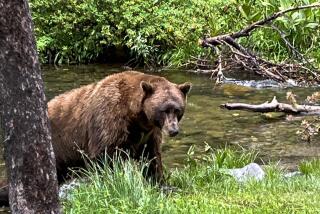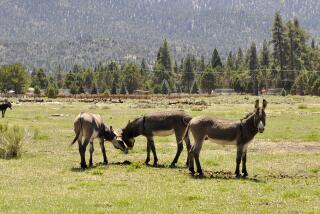Bavaria Rids Itself of Bruno the Rambling Wild Bear
- Share via
BERLIN — Bruno has eaten his last sheep.
The 220-pound brown bear who knocked over honey pots and ravaged livestock, who roamed the Bavarian Alps like an outlaw on the run, eluding farmers and Finnish hounds, was tracked by three hunters and shot just after dawn on a partly cloudy Monday.
The first wild bear known to have meandered into Germany in about 170 years was “painlessly done away with” near the town of Bayrischzell, said Otmar Bernhard, undersecretary of the Bavarian Environment Ministry. “We will perform a genetic examination of the bear, then preserve and exhibit him in the museum for man and nature in Munich.”
Outrage echoed from mountain ridge to valley. “Bears of the world: Avoid Bavaria,” said Hubert Weinzierl, president of the German Ring of Nature Preservation. “In other countries, bear and man are living peacefully together. Only in Germany is the bear liquidated.”
Wandering up from Italy and across Austria last month, Bruno was magical and mercurial, a bit of fairy tale in the land of lederhosen. He was given the scientific name JJ1. The media preferred Bruno; farmers called him things you couldn’t print. He had a taste for chickens and sheep, and dined on at least one pet guinea pig. At once adorable and menacing, he left bloody footprints and dozens of carcasses across meadows and riverbanks.
Bruno began sniffing closer to homes and seemed more mystified than frightened by humans. He bumped into a car two weeks ago and was spotted swimming nonchalantly across lakes. The farmers said he had to go. But taking a contract out on a bear who had suddenly turned into a brazen celebrity, an animal whose likes hadn’t been seen in Germany since the days when Beethoven’s music was not classical but new, proved a cumbersome task.
A plan to lure Bruno into a trap baited with meat didn’t work. Neither did shooting him with a drug-tipped dart and dragging him far away. Special hunting dogs called in from Finland overheated while chasing Bruno and had to return home. A suggestion to entice him with a female bear was discounted when it was noted that Bruno was too young and perhaps more enamored with beehives than sex.
“Bear Threatens Bavaria,” read the headline in the German newspaper Die Tageszeitung.
Bruno was wonderful copy. He was a late spring diversion, a lone rascal in the woods evading all who were sent after him. He unwittingly left clues: a broken branch, a knot of fur on a barbed wire fence. He was that thing you talked about over a beer. “Did you see what that crazy bear did?” German wildlife experts, scientists and farmers hunkered around maps and charts.
Bruno was a link to generations ago when bears roamed the continent, before their territory was squeezed by ski resorts and unfolding cities. Today, bears from Slovenia are being reintroduced into parts of Western Europe, including Austria and northern Italy. But few have the aura of Bruno.
A “Hunt Bruno” game appeared on the Internet, and German media reported that a special-edition Bruno teddy bear had sold for $150. But fame, even for a bear, is fleeting. The World Cup stole some of Bruno’s hype, pushing him to the back pages of newspapers. Then, on Sunday, the “problem bear” sashayed past a hiking lodge. The Bavarian Environment Ministry issued a shoot-to-kill order.
“We knew the decision was very unpopular,” said Anton Steixner, a member of the local government in Tirol, Austria, where Bruno had also snatched sheep. “To the fanatic animal protectors, I say you should understand this bear has been killing because of his lust for killing and not because he was hungry.... He was an eccentric and he was a border crosser.”
A condolence blog appeared hours after Bruno’s death. One person wrote: “In Alaska they say, ‘The worst bears are the human bears.’ ”
More to Read
Sign up for Essential California
The most important California stories and recommendations in your inbox every morning.
You may occasionally receive promotional content from the Los Angeles Times.











